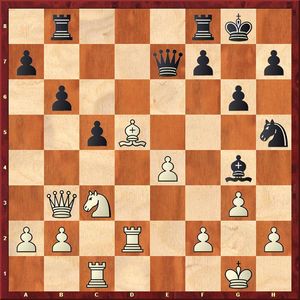8 September 2016
Fading Away
Vladimir Barsky reports on the Round Four.
The first crucial matchup against the Ukrainian grandmasters was initially unfolding more than OK for our men’s team. On the white color boards Tomashevsky and Grischuk were pressurizing, Kramnik had already built up a reinforced concrete line of defense (besides, the assurance in Vladimir’s having prepared everything at home was habitually strong), whereas despite Nepomniachtchi’s getting worse against Korobov, a certain amount counterplay was still there at his disposal. The hackneyed phrases would spring to mind about the higher the level of opponents, the more important the right of the first move and about a difficult trend of our days of going into big fights as Black. However, towards time trouble periods all hell broke loose so that on three out of four boards White’s advantage faded away like white smoke.
The first duel to end was the one on board 3, in which Ian, as usual, drove his opponent into the severest of time pressures.
Korobov – Nepomniachtchi

White seized the center, but prior to launching the offensive he should have calmly regrouped his pieces to have his back ranks protected: 21. Re1 b5 22. Qc2. Anton, however, surged forward without any delay.
21. f4 Rbd8 22. e5 Nf6!
The engine votes for 22...g5, but 23. Ne4 gxf4 24. Nd6 gives rise to unfathomable complications. Ian reacted in a more simplistic and human fashion by rerouting his knight back into the game.
23. Rcc2
Taking the knight is clearly not an option since one of White’s rooks is going to drop after delivering a check on e3.
23…Nxd5 24. Nxd5 Qe6 25. Nf6+ Kg7 26. Nxg4 Qxg4 27. Kg2 Qf5

28. Kf3
The king went to war, but he should have rather stayed home. After 28. Qc4 position would have remained approximately equal since weakening of the castled position is not going to tell.
28... h5 29. Qe3 Qh3!
An unpleasant infiltration from the home rank is in the air; Black manages to open up the h-file and swing the rook into the offensive.
30. Qe2 h4 31. Rxd8 hxg3 32. hxg3 Rxd8 33. Rd2 Rh8 34. Rd1 Qh5+ 35. g4
Even though 35. Ke3 Qf5 36. Kf3 is a more tenacious defense, here Black can calmly go on consolidating his position with 36...a6, for example.
35... Qh4
This careless move afforded White a chance to bail out. Stronger is 35...Qh3+ 36. Ke4 Qg3 37. Qf3 Qh2, and Black succeeds in shattering the opponent’s defensive formations.

36. Ke4
36. Qg2! Qe7 37. Rd5! looks like a saver; however, finding such moves while in time trouble is unrealistic.
36... Qe7 37. Kd3 Qd7+ 38. Ke3
In the case of 38. Kc2 Qa4+ 39. Kb1 the fate of the game is sealed by 39…Rh2! 40. Qd3 Qxf4.
38... Rh3+ 39. Ke4 Qc6+ White resigns.
However, the Ukrainian team equalized before long.
Grischuk – Volokitin
English Opening А05
1. Nf3 Nf6 2. g3 g6 3. Bg2 Bg7 4. c4 c6 5. b3 Ne4 6. d4 d5 7. 0-0 0-0 8. Bb2 Bf5 9. Nbd2 Qa5 10. e3 Nd7 11. Qe2 Rfe8 12. Nxe4 Bxe4 13. Bh3

As early as only after 12.5 moves there arose an original position of a very tense nature. White’s idea is obvious: should his opponent play straightforward 13…е6 or 13…Rad8, he would retreat his knight to d2 to exchange the е4-bishop in a situation most convenient for him. Neither Black can put up with 13...Bxf3 14. Qxf3 e6 - even though his setup is solid, but it is devoid of any fighting potential for him, whereas White’s bishop pair will likely take its toll sometime later in the game.
Andrei Volokitin, known as a calculating player, spent a lot of time calculating lines in this position. He is likely to have studied the 13...Nc5!? knight lunge consequences, threatening Bd3. Taking the pesky knight is a bad idea in view of 14. dxc5 Bxb2 15. Qxb2 Bxf3, whereas 14. Rfd1 dxc4 15.bxc4 Na4 is also to Black’s advantage.
White would have obviously needed to relieve tension on the board with 14. cxd5!? Bd3 15. Qe1 Qxe1 (15...Qb5 is unpleasantly met by 16. Qc1!, defending the hanging b2-bishop) 16. Rfxe1, e.g.: 16…Be4 17. Ng5 Bxd5 18. e4 Nd3 19. exd5 Nxb2 20. dxc6 bxc6 21. Nf3 – even if White has any advantage here, it is a purely symbolic one.
However, the Lviv grandmaster opted for a sharper continuation by leaving his knight en prise.
13…dxc4!? 14. Bxd7
There is no choice since after 14. bxc4 Qh5 15. Bg2 e5 the initiative is with Black even without his having sacrificed any material at that.
14... Qh5!
This is the point of Black’s play: the queen has swung from one flank to another to capitalize on the weakened squares around the opponent’s king.
15. g4
Again the only move. If 15. Kg2, then 15…Red8 16. Bh3 g5 17. g4 Qh4; the white pieces are deadly pinned and the rook lift along the sixth rank to either f6 or h6 allows Black getting a decisive advantage.
15... Qh3 16. Ne1 Bd3 17. Nxd3 cxd3 18. Qxd3 Rad8
In the case of 18... Red8 19. Bxc6 bxc6 20. Qe4 White would have ended up being up a half tempo if compared to what happened in the game.

19. Bxc6
If he wanted to, Grischuk could draw with 19. Bxe8 Qxg4+ 20. Kh1 Qf3+ 21. Kg1, upon which Volokitin would be forced to deliver a perpetual since after 21…Rd5? 22. Rfc1 the white king escapes the opponent’s fire unscathed.
19... bxc6 20. Qe4 c5 21. Rad1
White should have clarified the situation in the center immediately. Although after 21. Rac1 (21. Rfc1!?) 21…cxd4 22. Bxd4 Bxd4 23. exd4 Rd6 Black is down a pawn, he is well compensated for it.
21... h5 22. gxh5 (22.Ba1!?) 22... Qxh5

23. f4
This is only an illusion that White thus succeeds in preventing the undermining advance e7-e5, but he rather weakens his back ranks even further. Either 23. f3 or 23. Rd2 should have been preferred instead.
23...Qe2
Even stronger is 23... e5!, e.g.: 24. fxe5 Bxe5 25. Qg2 Bf4! 26. exf4 Re2, and Black is winning.
24. Ba1
Neither 24. Qg2 is convincing: 24...Qxe3+ 25. Kh1 cxd4, but White could escape with 24. Bc1! cxd4 25. Rd2, e.g: 25…Qxe3+ 26. Qxe3 dxe3 27. Rxd8 Rxd8 28. Bxe3.
24... cxd4 25. Rde1 Qg4+ 26. Qg2 Qxg2+ 27. Kxg2 dxe3

28. Re2
28. Bxg7 is decisively met by an intermediate check 28…Rd2+!
28... Bxa1 29. Rxa1 e5 30. fxe5 Rxe5 31. Rae1 Kg7 32. Kg3 Rde8 33. h3 f5 34. Kf3Rh8 35. Kg3 g5 36. Rh2 f4+ 37. Kf3 Kf6 38. Rc1 Kf5 White resigns. Andrei Volokitin handled this game very ingeniously, demonstrating a great deal of power play along the way. Alexander Grischuk has been coming up with strongest rejoinders for the major part of the game, but in time trouble he failed to keep true to the correct course nonetheless.
Evgeny Tomashevsky, being in a position with a stable advantage, committed a blunder and went down. This game will be commented by Dmitry Kryakvin in his review, but here is what the game winner has to say.
Ruslan Ponomarev:
– I was playing the black pieces and, in general, there arose a quiet and solid opening setup. My handling the game precisely is highly unlikely, however. If you start analyzing the game, you will notice my losing some tempi for knight moves. I think White’s perspectives would have been preferable in view of his space advantage should he have opted for maintaining tension in the position. However, nothing special was underway -- it was just that the game was somewhat stressful because of the match significance: it was yet round four, but the strongest teams started challenging each other already . Being under this pressure, my opponent simply blundered a pawn and I took it, that’s all.
Once Tomashevsky stopped the clock, Eljanov offered Kramnik a draw, thus sealing the 2.5-1.5 match victory.
Pavel Eljanov:
– I was squeezing and was better on clock time, but did not see how to break through. Perhaps, I was winning at some point as there were different options of breaking through with either g5-g6 or h5-h6. However, there was no reason to take risks: I saw that Ruslan was winning, so I just offered a draw. From the practical point of view this position is difficult to win, although it should objectively be a winning one, but I’m not completely sure.
Russia’s captain Andrey Filatov congratulated the captain Oleksandr Sulypa on victory and treated him to an elite tea that our team brings along in a thermos.
Unfolding no less difficult was the match of the Russian girls either. On board 3 Petra Papp sealed a draw as White against Aleksandra Goryachkina, while on board two Szidonia Lazarne Vajda successfully sacrificed the exchange to escape with a draw against Valentina Gunina. The match victory to our team was brought by Natasha Pogonina.
Pogonina - Gara

White sacrificed a pawn in the opening, and now her bishops are very powerful, while the central pawn phalanx is ready to start rolling any moment soon.
17.Qa3! c5?!
17...Re8 loses to 18.Qb3, forking f7 and а4 (moreover, the b7-pawn is hanging as well, which is peanuts in comparison, however). More stubborn is 17... Nb6, which Natalija planned to meet by 18. Bd3 Re8 19. c4 with more than sufficient compensation for the missing pawn.
18. dxc5 Rc8
18...Bc6 was a must, although even this situation is not a cup of tea for Black either.
19.c6! Bxc6 20.Bxe7 Qd7 21.Bxf8 Rxf8 22. Rfd1, and White went on to convert her extra exchange.
However, in order to retain the winning score the team leader Alexandra Kosteniuk had to defend a difficult endgame against Hoang Thanh Tran for almost as long as 70 moves. The 12th World Champion coped with her task brilliantly, and the Russian women’s team scored the fourth match victory.
Among other events of the day we should note the victory the Minister of Finance of Latvia Dana Reizniece-Ozola over the current World Champion Hou Yifan. This said, Dana’s victory is an absolutely deserved one after her launching an irresistible kingside attack. No one should be underestimated, you should not relax even for a minute!






















